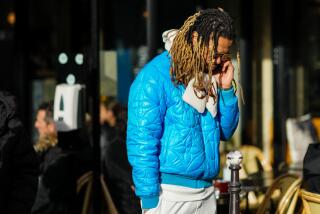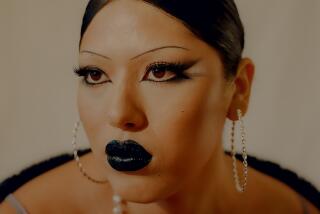You Can Learn a Lot by Splitting Hairs
- Share via
The Booster Shots editor hates it when I write about the mail I get. (“It’s so passive,” she says.) But I ask you: What am I to do when I get a letter from a reader who lovingly includes some of her hair?
In her youth, this reader--who prefers not to be identified by name--had gorgeous, sleek, golden tresses. Now “some of the hairs on my 73-year-old head are going from normal, like this, to abnormal, like this,” she wrote, referring to the hairs, which she’d glued to the page. (The “abnormal” hair is thicker and coarser than head hair tends to be.) “Is it just part of the aging process?”
Since our request to turn the Health editor’s office into a diagnostic lab has not yet received management approval, we searched the Web to see if we could find an answer. An interesting site--https://www.keratin.com--focuses on hair loss but is also an all-around hair biology extravaganza. We e-mailed the Web site’s creator, hair scientist Kevin J. McElwee, with our query. Here’s what he had to say:
Most likely, hormones are at the root of this alteration, he writes. In general, hair quality deteriorates somewhat after menopause as estrogen levels decline.
First of all, since estrogen stimulates hair growth, you can lose hair when the hormone goes away (though dermatologists are in disagreement about just how important this estrogen effect really is).
As the estrogen levels wane, relative amounts of androgens (male hormones) tend to rise--and these can also cause head hair to thin. So, hey--things could be worse than having a few fat frizzy hairs.
But what about those fat frizzy hairs? These traits are also caused by the androgens, McElwee says. Some folks, in fact, develop this kind of fatter, frizzier hair all over their scalps, a condition which is referred to as “kinky hair syndrome.”
Fat Hair Days
Here’s some other sundry hair facts we gleaned from McElwee and his Web site:
* Thickness of hair can vary widely--it depends on a small group of cells sitting at the bottom of the hair follicle, the place where a hair grows. The more of these cells there are, the fatter the hair. Asian hair tends to be the thickest and coarsest, Nordic hair the thinnest.
* Luckily, the hair follicle is surrounded by a fibrous capsule. Otherwise, the hairs might start growing down--into our skin--instead of up, and out.
* Your average human being has about 5 million hair follicles, 1 million of them on the head. (That must have been an exciting PhD project.)
* We have hair follicles all over the outside of our bodies--except for the palms of our hands and the soles of our feet.
* Of Caucasians, red-haired people have the least dense scalp hair. Blonds are the most dense and people with brown hair somewhere in between.
* Sometimes, people can develop odd patches of gray or white hair for no known reason. (This happened to the beard of a friend of mine, but in his case--and it was an amazing sight to see--he had red and brown patches as well.) The cause? Inflammation or other damage to the ever-so-sensitive pigment-making cells, called melanocytes. It’s quite easy to switch these cells off or even destroy them completely.
* Head hair grows about .35 milimeters per day, and possibly slightly faster in females (.36 milimeters) than males (.34 milimeters). Eyebrow hair is really slow (a measly .16 milimeters per day).
* Every hair has its job. For instance, eyebrows and eyelashes protect the eyes by sweeping away or channeling fluids or dust and shielding the eye from too much glare from the sun. Body hairs help insulate the skin or--like a beard--can signify “sexual maturity.” And nose hairs capture foreign particles in the air before they get whooshed down into the lungs. So think twice before you trim those hairs!
*
If you have an idea for Booster Shots, write or e-mail Rosie Mestel at Los Angeles Times, 202 W. 1st St., L.A., CA 90012, rosie.mestel@latimes.com.


